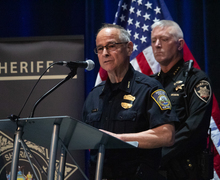SU Indigenous students find Columbus statue ‘offensive and threatening’
Wendy Wang | Assistant Photo Editor
Syracuse community members have called for the statue to be taken down and Columbus Circle to be renamed, but the measures have faced opposition.
Get the latest Syracuse news delivered right to your inbox.
Subscribe to our newsletter here.
Indigenous students and faculty at Syracuse University have expressed their frustration toward celebrations surrounding the statue of Christopher Columbus in Syracuse.
Syracuse is home to a large Italian American population, including community members who believe the removal of the statue would be disrespectful to the history of immigrants in this country. But other Syracuse community members have called on the city to take down the statue and rename Columbus Circle downtown.
Mayor Ben Walsh announced the city’s plans in 2020 to remove the statue. To continue honoring the Italian Americans in the city, Walsh said the city plans on keeping the fountain and monument at the center of the circle.
In May, the Columbus Monument Corporation filed a lawsuit against the city, saying Walsh had no legal authority to move the statue.
Neal Powless, Syracuse University’s ombuds and a leader in the Onondaga Nation, said he’s been advocating for the statue’s removal his whole life. These conversations need to exist beyond Indigenous Peoples’ Day in October, he said.
“Unfortunately, in order to have compromise (and) collaboration, both parties need to be willing to have a conversation,” Powless said. “The group that is fighting the city is not willing to listen.”
The statue acts as a direct attack on Indigenous people in the city and in the greater United States, Powless said.
“It’s a pervasive dialogue that pits Indigenous people as not rightfully belonging to the land, and the statue represents that,” he said.
Olivia Porter, a member of Seneca Nation and a junior in the College of Arts and Sciences, agreed with Powless, saying the statue sends a direct message to Indigenous people.
“(The statue) is offensive and threatening and sends the message, ‘You’re not welcome here,’” Porter said.
SU has hosted events on campus honoring Indigenous Peoples’ Day, as well as honoring the Onondaga Nation and Haudenosaunee Confederacy. SU, which was founded on Onondaga Nation land, now starts events on campus by honoring the land that the university resides on.
Also, SU has begun flying the Haudenosaunee flag at the National Veterans Resource Center, in the Carrier Dome and in front of Hendricks Chapel. The Barnes Center at The Arch also recently hired an Indigenous healer, Diane Schenandoah, who hopes to offer support to Indigenous students using traditional practices for healing.
But students expressed that they want the university to do more to honor the Onondaga Nation, especially in classrooms.
Mario “Ma’ii” Villa, a graduate student in the School of Information Studies and a member of the Chiricahua Apache, said that many people are not aware of Indigenous students’ presence in Syracuse. Many people, he said, think that they have gone extinct.
Nizhoni Kennedy, a freshman at SU who is Seneca and Navajo, agreed, saying a lot of students she has encountered are unaware of the history SU has with Indigenous people, land and culture.
“A lot of people when they come to Syracuse don’t know it sits on Onondaga land or who the Onondaga are,” Kennedy said. “People don’t understand what colonization did to us. We lost millions and millions of ancestors, and it didn’t stop in 1492.”
It’s the city’s turn to honor Indigenous people, several students and faculty members said.
“I’m just a community member, a leader, in the Onondaga Nation. It is a part of a larger dialogue I’ve been having my whole life,” Powless said.
Villa said the Columbus statue needs to come down and that governments, both locally and nationally, need to pay attention to Indigenous voices.
“All voices should be heard in making decisions, because it is supposed to be a democracy,” Villa said. “I think it’s important for all of us to realize that the difficult steps are necessary. This will make society a just one, when we can all start working together.”
The statue is not honoring history, but a man who destroyed lives, Villa said.
“The removal of the statue is not a removal of history,” Villa said. “We need to acknowledge that history happened. We need to reconcile.”
The removal of the statue is not a removal of history. We need to acknowledge that history happened. We need to reconcile.Mario 'Ma’ii' Villa, iSchool graduate student at SU
This year’s celebrations for Indigenous Peoples’ Day were different after President Joe Biden acknowledged the holiday, but there is much more to be done, Porter said.
“There needs to be an understanding that Columbus does not represent the beginning of North America. He represents genocide and almost complete destruction of Indigenous people … He marks the beginning of the downfall,” Porter said. “We are still here, we are resilient, but we wouldn’t have to be resilient if it weren’t for him.”
Published on October 27, 2021 at 12:13 am





